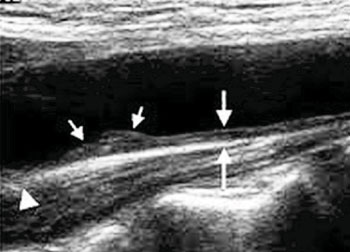Vascular Disease Plasma Marker Confirmed in Diabetes Patients
By LabMedica International staff writers
Posted on 02 Feb 2016
Pre-kallikrein (PK) has previously been suggested as a marker for diabetic vascular disease of the kidneys, but a new study supports the idea that increased plasma PK levels are an independent risk factor for whole-body diabetic vascular disease, similar to the risks of high triglycerides or high blood pressure in heart disease.Posted on 02 Feb 2016
The types of blood vessel malfunction seen in patients with diabetes causes the cells of the intima-media to spread to the surface, allowing PK to contact them directly and this contact closes the circuit of an alternative pathway of chronic inflammation. Scientists who study the kallikrein-kinin system suspect that this chronic inflammation is responsible for the blood vessel thickening observed in diabetic kidney disease, retinopathy, and atherosclerosis.

Image: Carotid Intima-Media Thickness (CIMT) ultrasound exam showing a carotid artery with a wall that is much thicker than normal and mild plaque formation (Photo courtesy of Preventive Cardiology Consultants).
Scientists at the Medical University of South Carolina (Charleston, SC, USA) and their colleagues enrolled participants in Epidemiology of Diabetes Interventions and Complications (EDIC), a multicenter longitudinal observational study of the development of macrovascular complications and further progression of microvascular complications. The study was conducted on a subset of 636 subjects from the Diabetes Control and Complications Trial DCCT/EDIC cohort.
Plasma PK was activated with ∼0.4 nmol/L Hageman factor fragment (betaFXIIa), and the formed plasma kallikrein was detected by hydrolysis of the chromogenic substrate H-D-Pro-Phe-Arg-paranitroanilide (DiaPharma; Franklin, OH, USA) according to the published procedure, and was expressed as units per milliliter (U/mL). Factor XII:coagulant and high molecular weight kininogen (HK):coagulant, plasma concentrations of fibrinogen and plasminogen activator inhibitor (PAI-1) activity levels were also determined. Carotid intima-media thickness was measured by B-mode ultrasonography.
The circulating levels of plasma PK were measured in 636 type 1 diabetic subjects from plasma collected in years 1997–1999. The PK levels were symmetrically distributed and ranged from 0.2-3.0 U/mL, with a mean value of 1.29 U/mL. A positive and significant association was found between PK levels and body mass index (BMI), and with HbA1c, a marker of metabolic control. They also found that patients with higher levels of PK in their blood have thicker layers of intima-media in the vasculature of their carotids.
Ayad A. Jaffa, PhD, the senior author of the study said, “These preclinical studies not only will give us insights into the involvement of plasma PK in vascular disease, but will also contribute to development of novel treatment strategies for diabetic vascular disease.” The study was published ahead of print on November 24, 2015, in the journal Diabetes.
Related Links:
Medical University of South Carolina
DiaPharma




 assay.jpg)









